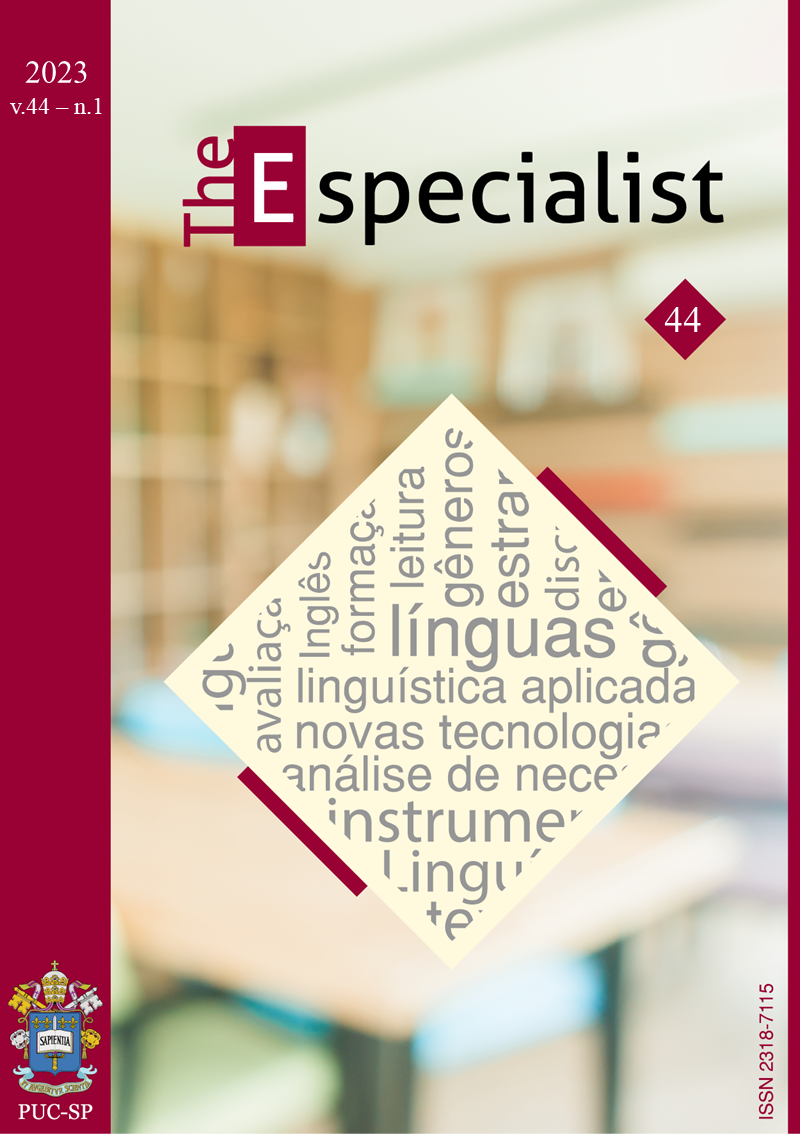Diy Videolessons
miniseries to guide the design of video lessons for teaching English as an additional language
DOI:
https://doi.org/10.23925/2318-7115.2023v44i1a9Keywords:
English as an aditional language, videolessons, multimodal genre, digital material, rethorical organizationAbstract
The video lesson is a rising multimodal genre in literacy events in the digital context due to its intense use in online education. Therefore, studying the rhetorical organization of this genre, its consumption, production, and dissemination, is important to support new interdisciplinary studies. In this article, we present the rhetorical organization description of video lessons, through the analysis of 14 samples, and the proposal of digital material as a short series. Results indicate the relevance of the developed material, as it aimed to assist teachers in understanding the genre, typologies, and its production process for use in English as an additional language class
References
ALMEIDA, W. T. M; SABOTA, B. Análise de potencial das videoaulas como material didático para o ensino de Inglês. In: Seminário de Pesquisa, Pós-Graduação, Ensino e Extensão do CCSEH – SEPE, 2015, Anapólis. Anais: UEG, 2015. p. 1 - 5.
ARROIO, A.; GIORDAN, M. O Vídeo Educativo: aspectos da organização do ensino. Química Nova na Escola, v. 24, p. 8-12, 2006. Disponível em: <http://www.lapeq.fe.usp.br/meqvt/disciplina/biblioteca/artigos/arroio_giordan.pdf>. Acesso em: 10/09/2017.
BAWARSHI, A. S.; REIFF, M. J. Genre: An Introduction to History, Theory, Research, and Pedagogy. Indiana: Parlor Press, 2010.
BEZERRA, F. S.; HEBERLE, V.; NASCIMENTO, R. G. Multiletramentos: iniciação à análise de imagens. Linguagem & Ensino, Pelotas, v.14, n.2, p. 529-552,jul./dez. 2011.
BEZERRA, B. G. (2002). A organização retórica de resenhas acadêmicas. Linguagem em (Dis)curso, 3(1).
BRASIL. Base Nacional Comum Curricular. Brasília: MEC, 2017. Disponível em: http://basenacionalcomum.mec.gov.br/images/BNCC_20dez_site.pdf. Acesso em: 3 de março de 2020.
FILATRO, A. Como preparar conteúdos para EAD. [Digite o Local da Editora]: Editora Saraiva, 2018. 9788553131419. Disponível em: https://integrada.minhabiblioteca.com.br/#/books/9788553131419/. Acesso em: 13 Jan 2021
GODOY, Arilda Schmidt. Introdução à pesquisa qualitativa e suas possibilidades. RAE - Revista de Administração de Empresas, São Paulo, v. 35, n. 2, p. 57-63, 1995.
HAUPT, C.; VIEIRA, M. M. C. Língua inglesa como língua adicional: cultura e contextos (English as additional language: culture and context). Estudos da Língua(gem), [S. l.], v. 11, n. 2, p. 83-102, 2019. DOI: 10.22481/el.v11i2.5486. Disponível em: https://periodicos2.uesb.br/index.php/estudosdalinguagem/article/view/5486. Acesso em: 16 jun. 2022.
HENDGES, G. R, (Orgs.). Análises de textos e discursos: Relações entre teorias e práticas. Procedimentos e categorias para a análise da estrutura textual de gêneros. PPGL/ UFSM. Santa Maria, 2008.
KARPPINEN,P. (2005) Meaningful learning with digital and online videos: Theoretical perspectives. AACE Journal, 13, 233 – 250.
MARTIN, J. R. (1984/2001). Language, register, and genre. In: BURNS, A.; COFFIN, C. (Eds.). Analysing English in a global context. London: Routledge. p. 150-166.
MOTTA-ROTH, Désirée. Análise crítica de gêneros: contribuições para o ensino e a pesquisa de linguagem. DELTA [online]. 2008, vol.24, n.2, pp.341-383. ISSN 0102-4450.
MORÁN, J. M. O vídeo na sala da aula. Comunicação e Educação, São Paulo, (2): 27 a 35, .jan./abr. 1995.
MUSSIO, S. C. Videoaulas de escrita/redação científica na internet: um estudo bakhtiniano. Tese (Doutorado em Linguística e Língua Portuguesa) – Faculdade de Letrase Ciências Humanas. Universidade Estadual Paulista. Araraquara. p. 342. 2016.
OLIVEIRA, A.; STADLER, P. C. Vídeo-aulas: uma forma de contextualizar a teoria na prática. Curitiba, 2014. Disponível em: <http://www.abed.org.br/hotsite/20-ciaed/pt/anais/pdf/352.pdf>. Acesso em: 10/09/2017.
Ou, C., Joyner, D.A., & Goel, A.K. (2019). Designing and developing video lessons for online learning: A seven-principle model. Online Learning, 23(2), 82-104.
SAVI, R. et al. Proposta de um modelo de avaliação de jogos educacionais. Novas tecnologias na educação. v. 8 Nº 3, dez, 2010. Disponível em:<https://seer.ufrgs.br/renote/article/view/18043>. Acesso em: 19 mai. 2018.
SCHLATTER, M; GARCEZ, P. M. Línguas Adicionais (Espanhol e Inglês). In: Rio Grande do Sul, Secretaria de Estado da Educação, Departamento Pedagógico. (Org.). Referencias curriculares do Estado do Rio Grande do Sul: linguagem, códigos e suas tecnologias. Porto Alegre: Secretaria de Estado da Educação, Departamento Pedagógico, 2009, v. 1, p. 127-172.
FERRÉS, Joan. Vídeo e Educação. 2 a ed., Porto Alegre, Artes Médicas, 1996
SPANHOL, G. K.; SPANHOL, F. J. Processo de Produção de Vídeo-Aula. Santa Catarina: [s.n.], 2009.
WINTER, Daiane. O uso do vídeo como instrumento de motivação na aula de língua estrangeira. 2013. 94 f. Dissertação (Mestrado em Letras) - Universidade Catolica de Pelotas, Pelotas, 2013.
Published
Versions
- 2023-05-22 (2)
- 2023-05-12 (1)
How to Cite
Issue
Section
License
Copyright (c) 2023 The ESPecialist

This work is licensed under a Creative Commons Attribution 4.0 International License.
The authors grant the journal all copyrights relating to the published works. The concepts issued in signed articles are the absolute and exclusive responsibility of their authors.


 Esta obra está licenciada com uma Licença
Esta obra está licenciada com uma Licença 